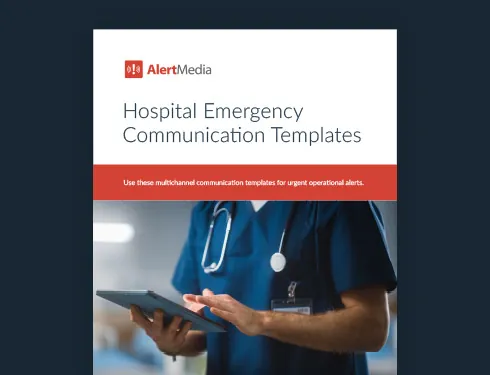![Streamline Ambulance Diversion Communication [+Templates]](https://www.alertmedia.com/wp-content/uploads/2023/02/Blog-Ambulance-Diversion-V3b-1024x536.jpg)
Streamline Ambulance Diversion Communication [+Templates]
When hospitals hit capacity and can’t take on any additional patients, communication becomes a lifeline. The time to get clear on your communication plan for ambulance diversions is now, not after you’ve had to start turning patients away.

Hospital overcrowding was everywhere in the news during the peak of the COVID-19 pandemic. Emergency rooms were beyond capacity, patients were being treated on beds in hallways—if there were any hospital beds left at all—and some cities had reports of ambulances circling for hours with nowhere to take patients in need of critical care. There were simply too many people needing care and not enough staff or space.
The tragedy of the pandemic turned ambulance diversions—once a rare and concerning occurrence in hospital systems—into a frequent reality for healthcare facilities. And with continued strains on staffing and consistently high emergency room demand, even outside of normally busy flu seasons, ambulance diversions are likely to persist.
When a hospital goes on diversion and all new ER patients and ambulances are sent to nearby facilities, having a reliable communication plan is the best way to make sure you can care for your patients, support your staff, and turn off your diversion alert as quickly as possible.
Download Our Hospital Emergency Communication Templates
Why Is Communication So Important During a Diversion?
Communication in hospital settings is critical no matter the scenario. During a hospital diversion, when resources are strained and staff are already at their limit, having a clear communication plan and simple alerting process will make sure everyone is on the same page. Communication about your hospital’s diversion status and patient flow has implications within your facility, your provider network, and your wider community.
Any interruption or overcrowding in emergency care can have rippling effects on public health. When there aren’t enough inpatient beds in one facility, that means many patients are forced into out-of-network hospitals and are often sent to hospitals further from their personal support network of family and friends. There are also documented instances of patients who are sent to another hospital and receive subpar care due to a lack of documented patient history.
Being able to communicate with all relevant parties during an ambulance diversion means you can be more efficient in your response and provide a higher level of care. Departments not on a diversion might be able to move patients around, you can efficiently transfer medical records on patients who are moved to other facilities, and EMTs will have more information to give inbound patients about wait times, transport times, and diversion hours. Clear communication is how hospitals can get back to normal patient flow as soon as possible.
How do AlertMedia customers communicate about ambulance diversions?
Diversion alerts are one of the many ways our hospital customers use the mass communication system. The solution works for both large and small hospital systems. Smaller or single-location hospital customers can alert different departments within the facility of a diversion, as well as keep hospital leaders informed about current statuses. They also can keep ambulance services up to date. Larger hospital systems, like those with networks spanning whole regions or even across the U.S., are able to communicate between their facilities as needed.
Diversion alerts are also one of the most common notifications we see our hospital customers sending, with multiple alerts going out every day. Two-way communication allows these facilities to hear from their staff directly when a diversion has resolved or when a diversion must be extended. And when the “all-clear” goes out, these facilities can trust everyone will get the message as quickly as possible, so they can go back to accepting and helping new patients.
Integrating Communication Into Your Hospital Diversion Policy
If your facility already has a hospital diversion policy, it’s a good idea to check and make sure you’ve integrated communication planning. Alongside your policies on staffing ratios, maximum ER wait times, length of stay for admitted patients, and triage criteria, make sure you have documentation about who will be communicating and what will be included in that messaging. Your care providers need to know the plan to mitigate crowding in their departments and still provide the best quality patient care. Here are a few communication best practices to include in your ambulance diversion policy.
How to Communicate About Ambulance Diversions
1. Determine who needs to be alerted
The first step to good communication is knowing who to communicate with. When a diversion alert goes out, you want to have all the right groups of people in the know. But the “right people” will vary depending on which department is on diversion.
If you are setting your emergency department or ICU on diversion because you don’t have enough staff on shift, you may want to alert your contracted emergency medical services (EMS) providers and your hospital administrators. Whereas if you are putting your pediatrics or labor and delivery departments on diversion, you may have a different list that needs to be notified. Here are a few examples of groups and individuals you might add to the list for alerts:
- Hospital administration/medical director
- Nursing staff/administrators
- Onsite providers (doctors, nurses, techs, etc.)
- Nearest hospitals or trauma centers
- EMS systems/agencies
- Other hospital personnel
2. Build notification templates to streamline your messaging
As Josh Anderson, Manager of Safety, Security, and Emergency Management at Valley View Hospital put it, “I can get helicopters, doctors, and police officers, but I can’t get time. Time is the only resource that we cannot get more of.” When time and resources are already strained, you don’t want to add even more weight to your staff by asking them to write up diversion alert notifications from scratch. But there are some simple ways to save time long before you feel the crunch of staffing shortages and ED crowding.
Creating pre-built notification templates for these kinds of frequent events makes communicating a matter of just filling in pertinent details and hitting send. This is especially helpful if you are sending out diversion alerts for different departments or different hospitals in the same network.
Here are a few examples of ambulance diversion notification templates you can use:
Facility Alert — Diversion Alert. The [DEPARTMENT] is currently diverting all new patients to [LOCATION].
Facility Alert — Diversion Alert. The [DEPARTMENT] is currently diverting all new patients to [LOCATION].
We will notify you when the diversion has ended.
GET THE TEMPLATES
3. Prepare for complications
Like any emergency situation, there is always the possibility of complications. Ambulance diversions are no exception. Maybe there is a public health crisis and all other facilities near you are also on diversion. Maybe your hospital has been hit by the recent surge of ransomware attacks and your ability to intake patients is crippled. Maybe your emergency department has a rush of trauma patients from an active shooter event, but your operating room does not have the additional staff needed. Your communication plan should account for contingencies and support quick pivots without derailing your response.
One great tool for this is an active threat intelligence system. Having a way to keep an eye on your surrounding area to spot any potential threats that might complicate things means you have those few extra minutes to prepare and respond. You can spot severe weather threats as they approach your area and keep an eye on local violence or crime that might send an influx of patients in for emergency services. The health care system is an “always on” element of you’re the community, and being able to track what is happening in your surrounding area gives you an advantage to maintain quality care for your patients.
4. Run diversion alert drills
Whether hospital diversions are heading away from your facility or to your facility, these scenarios can add a significant amount of stress to your team, especially if you are introducing new communication protocols or tools into the mix. This is where emergency drills and practice exercises come into play. It’s a great idea to run your emergency department (or any department that might face diversions at some point) through a “dry run” where you practice all the steps of an ambulance diversion without including any actual emergency patients or EMS agencies. This will just be your team going through the steps to make sure everyone knows what to do.
If you can’t make a full-scale drill work, you can also lean on tabletop exercises, which use a lot of the same techniques as a drill but can be done in a conference room rather than the crowded emergency medicine floor. These tabletop exercises will get your team familiar with how to use the communication system and how to act on the alerts they will receive.
Communicating Through Everyday Crises
Healthcare is an industry where every day presents a new critical emergency to navigate. But with a solid communication plan and a reliable, easy-to-use system, you’ll be much better able to navigate any crisis.
Valley View Hospital is the perfect example of this. What was once a single-story hospital funded by locals has since grown into a thriving regional medical center spearheading care for an entire community. From the pandemic to natural disasters and severe weather on top of all the “normal” events a hospital faces, Valley View Hospital is no stranger to challenges. But the organization has prioritized communication and partnered with AlertMedia to communicate with both hospital staff and their surrounding community in a matter of seconds.
By linking a modern communication tool with staff expertise and quality service, Valley View can continue to accomplish its mission of putting patients first. “Four years ago, mass communication didn’t exist at Valley View,” says Josh Anderson. “Now… we can’t see ourselves living without it.”



![Disaster and Emergency Communication Plan—5 Steps [+Template]](https://www.alertmedia.com/wp-content/uploads/2022/03/BLOG-Emergency-Communications-Plan-V1.jpg)
